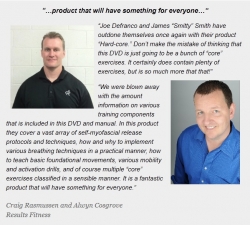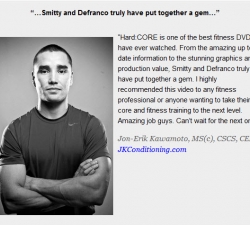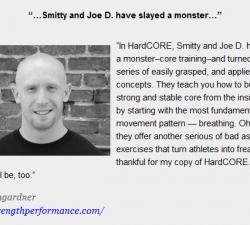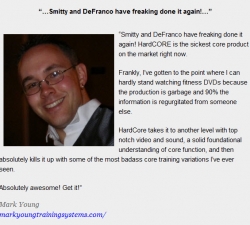This is NOT another “core” DVD that merely provides a few gimmicky “abdominal” exercises — the fitness industry is already flooded with these types of elementary DVD’s and we’re sick of it! So we decided to do something much different… something much more comprehensive… something much more revolutionary… something much more, HardCORE!!

Special Hard:Core exercises like ‘Swiss Ball Stir the Pot’ helped Triple H develop insane levels of dynamic core strength and anterior core stability. This enabled him to display his new-found strength – and stay healthy – during a grueling Wrestlemania match!
This newest DeFranco and Smitty collaboration, is one of the most comprehensive products ever created on true “core” training! Unlike other “core” DVD’s that just provide a bunch of abdominal exercises; this DVD provides a “3-Dimensional” look at what the core truly is, while providing you with over 260 exercises! (Yes – you read that right – there are over 260 exercises that are guaranteed to help you build a bullet-proof core!) Strength coaches, personal trainers, physical therapists, bodyworkers and athletes of all levels are going to be blown away with the scientific (yet practical) information provided in HardCORE! (There is also an 80-page manual that can be printed from the root of the DVD which provides the perfect compliment to the MASSIVE DVD.)
Isn’t it ironic that the term “Core” is the biggest buzz word in the fitness industry, yet 99% of the information provided by “experts” on the topic is INACCURATE?…
THIS IS ABOUT TO CHANGE!
HardCORE provides the truth, the whole truth, and nothing but the truth, regarding the foundation of all training – The Core!

- How to instantly improve your posture and quality of life, just by performing the exercises in Chapter 1!
- Learn the importance of neutral posture and it’s profound affect on mobilizing your tight hips and thoracic spine!
- Why the fitness industry is completely WRONG regarding traditional core training methods. Most “popular” methods will actually make you weaker and lead to injury! BUYER BEWARE!
- Our favorite soft-tissue methods/exercises for improving core activation, strength, and even your ability to breathe!
- Learn how breathing properly can positively affect your posture and strength potential!
- How to develop incredible rotational strength for super-human POWER!
- A brutally effective series of exercises that we feel are mandatory for ALL athletes!
- How to identify and instantly eliminate your weak links! This will greatly enhance your chance of victory and total domination on the athletic field!
- Simple modifications to ‘commonly performed exercises’ that can triple your core stability, which will lead to huge gains in strength and power!
- Why building core strength endurance is important for relieving and eliminating low back pain.
- Unique kettlebell exercises that will develop bulletproof core stability and balance!
- The importance of the posterior chain and how to rapidly develop these muscles in order to turn yourself into an immovable, unstoppable force!
- Prevent wasted time and decrease injury potential by omitting ineffective abdominal exercises from your program!
- Learn how to smash personal records and hit big weights on every lift, just by focusing on your breathing!
- Isolative Core Strength vs. Dynamic Core Strength: When should each be performed and why? Learn our favorite choices for each!
- Learn why ‘compound movements’ coupled with ‘direct ab’ work is NOT enough to develop your greatest potential core strength!
- Learn why we decided to shatter the myths and bring you the inside truth about how the body actually works to protect itself and develop the stability needed for real “functional strength”!
Hard:CORE System


Want More Information About the Premium Athletic Strength Development System – CLICK HERE
Yes, we ship all over the world.
Yes, HARD:CORE (and all of our DVD products) are formatted for all DVD players.
Please watch the video above for additional International shipping details. Our distribution center has told us that International orders can take upwards of 2-4 weeks for delivery – please be patient! If you have any questions, please email us at info [at] dieselcrew [dot] com.
There are over 260 different movements, exercises, and exercise variations targeting mobility, strength and stability in the HARD:CORE system.
Absolutely not! In HardCORE we decided to take on one of the most misunderstood facets of strength training today – core training. We are going to combine the latest core function research with our holistic and unique approach to strength training — detailing the science of how to stabilize the torso in preparation for strength training and sporting application. You’ll also learn the affect that immobility and dysfunction has on the ability to develop, and display, real, functional core strength. This integrated view will help you understand the critical factors involved in bracing, preventing injury, performing during sport and improving your overall quality of movement.
We lay out the programming for core exercises in great detail in the HARD:CORE manual (which is contained on the HARD:CORE DVD Disc 3). We detail how some ‘core-specific’ exercises are best done at the beginning of the workout and some should ONLY be done after the workout.

Want More Information About the Premium Athletic Strength Development System – CLICK HERE
The muscle groups that stabilize, protect the spine and engage movements of the torso do not act in isolation, so why engage in exercises that attempt to target only a few muscle groups that make up the core? Crunches have other issues as well. Too many crunches can shorten the depress the rib cage, which will affect your posture and breathing – if you don’t have a good holistic training program. Isolative core exercises can be incorporated into your program but they are only ONE part of a more comprehensive strategy.
Yes, wobble boards do have their place in a rehabilitative setting where a patient needs to reengage stabilizing muscles or re-establish balance and proprioception after an injury. They can also be used to develop shoulder and core stability by having the athlete setup in a push-up or plank position with their hands, elbows or feet on the wobble board. But, standing on a wobble board isn’t an effective training means as some coaches might have you believe. There is an inverse relationship between the stability of the base support and the power potential of the lifter or athlete.
Sport is not patterned and life is not patterned. The fairy tale environment that happens in the gym does not happen in the real world. You can’t set your breath, keep your spine in neutral and execute a perfect cadenced tempo for an exercise with each and every repetition. You must introduce ‘chaotic’ movements, in addition to conventional core training. This will provide the athlete with a comprehensive core strength profile. Loaded carries such as zercher sandbag carries, sled dragging variations, or various kettlebell carries, create a non-optimal environment that the athlete has to overcome to remain in a good position. This, in addition to conventional core exercises, will develop more ‘real world’ adaptations and powerful core strength.
As you move, your body adjusts and adapts. Once your body becomes accustomed to these movements, there is no more adaptation. The engaged musculature must be constantly challenged if you want to continue to make progress. This holds true for the muscles that surround, support and stabilize your core, i.e., the superficial outer core. The S.A.I.D. Principle and the Principle of Progressive Overload state that muscles adapt to imposed demands and that you must continually push yourself so that you don’t hit a training plateau. Adding resistance to your core training exercises and pushing yourself on your main compound lifts will continue to build next level core strength.
Life is not about slow movements. Life and sport are explosive and you must train the core to transfer forces efficiently. You must incorporate more dynamic movements to supplement your workout. Exercises such as medicine ball throws, elastic band snap downs or kettlebell swings are just a few examples how your can train explosively, reinforce good positioning and develop core stability.
Regulating your breathing patterns plays an important role in stabilizing the torso during any type of movement. By engaging optimal intra-abdominal pressure we can establish proper tension for any movement. Also, utilizing the deep-lying breathing muscles synergistically and isometrically contracting the muscles that surround the torso, we can maintain proper torso rigidity and stay safe. This is the essence of “bracing.” As you move, force is transferred across the kinetic chain, and dependent upon your or your athletes’ ability to sustain proper bracing, the force is either transferred efficiently or dissipated. This is very important for any sport that requires fast and powerful movements, i.e., ALL sports.
If you are just working on your “six pack abs” or trying to target the superficial ‘outer core’ (rectus abdominus, transverse abdominus, external and internal obliques) in your core training strategies, you are missing other very important components. Proper breathing, good posture and developing the posterior chain are the other missing pieces of the puzzle.
”I do 300 crunches, 400 crunches, 1000 crunches a day, to maintain my six pack!” Realistically, if you want a “six pack”, you need to be hyper-focused on your nutrition. And if you want core strength, you need to build up the core musculature comprehensively, i.e., both the anterior chain and the posterior chain with compound exercises. Let me ask you a question. If you can do 300, 400 or 1000 crunches, how hard can they be? You should focus on good quality exercises executed with proper form and focus on tension throughout the movement. This means a core-specific movements or compound movements should be incorporated with control (proper bracing) through the entire range of motion. Explosive core movements, such as medicine ball throws, can then be added once the athlete has shown proficiency with the basic movement patterns.
Belts are a great tool. A great tool to make you weak! Belts should only be used when needed, not all of the time. If you are teaching young athletes how to brace, a loose belt (even an elastic band – see the Hard:CORE system) is a good tactile tool to help them learn how to brace 3-dimensionally outward. But don’t wear a belt all of the time in the gym, because it will make you weaker. You won’t have to use your ‘natural belt’ or core for less than maximal efforts. If you are loading above 85%+ of the lifter or athlete’s one rep max (referred to as 1RM), a belt can then be used. Note: The 1RM is the absolute or total amount the lifter can lift in the respective exercise.
As stated, just because you’re ripped or shredded doesn’t mean anything when it comes to core strength. A ripped core only speaks to your current level of percentage of body fat. Having a strong core means that you are able to demonstrate stability across the torso when you move. Or more specifically, you can maintain proper positioning and bracing when your extremities (arms and legs) are in motion for any activity.

Want More Information About the Premium Athletic Strength Development System – CLICK HERE











